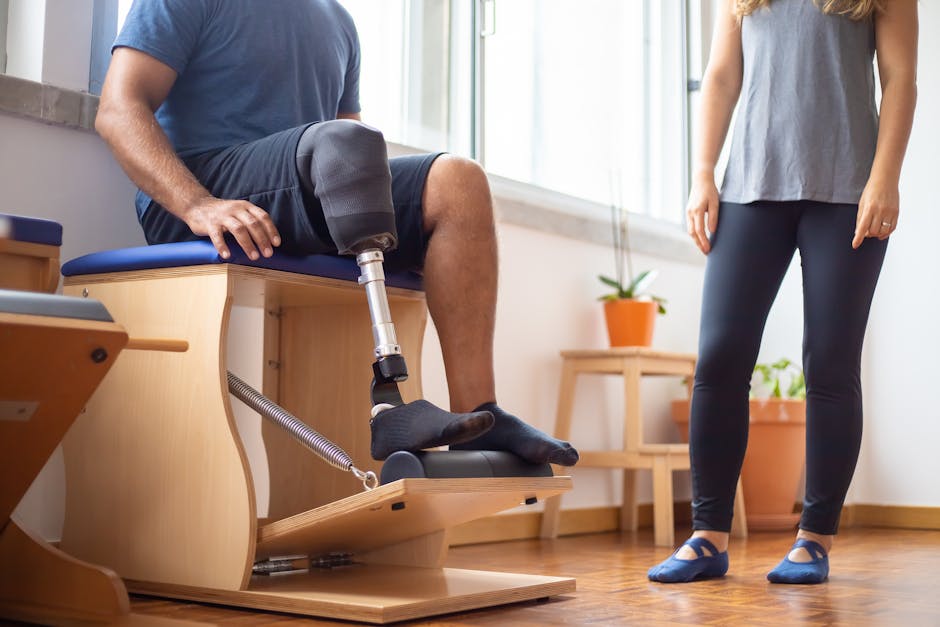Understanding Performance Recovery Therapy: An Introduction
Performance Recovery Therapy isn’t just a trend in the fitness world; it’s a crucial aspect that can significantly enhance your training results. At its core, this therapy focuses on helping you recover faster and more effectively after intense workouts. Think of it as giving your muscles the TLC they need to heal, grow, and strengthen. This therapy encompasses a variety of techniques—each designed to reduce muscle soreness, decrease recovery time, and prevent injuries. Some popular methods include massage, cold therapy, compression garments, and stretching exercises. It’s all about finding what works best for your body and including it in your fitness routine. Remember, quicker recovery means you can get back to training sooner, pushing you closer to your fitness goals. So, take the time to explore and incorporate Performance Recovery Therapy into your regimen. Your body will thank you for it.
The Role of Performance Recovery Therapy in Fitness
Performance Recovery Therapy plays a huge role in helping you hit your fitness goals. Think of your body like a car. Just like a car needs regular maintenance to run smoothly, your body needs recovery to perform its best. This therapy isn’t just about taking a break; it’s about actively helping your muscles and overall body to recover faster and stronger. Why does this matter? Because the quicker and more effectively you recover, the sooner you can get back to training. It squashes the chances of injuries by allowing for proper rest and repair. So, whether you’re lifting weights, running, or doing yoga, incorporating Performance Recovery Therapy like massage, stretching, and proper nutrition can make a big difference. And remember, it’s not just for pro athletes; everyone can see benefits, from casual gym-goers to weekend warriors. Think stronger, faster, and more resilient – that’s the power of Performance Recovery Therapy in your fitness journey.
Different Types of Performance Recovery Therapy Techniques
When it comes to getting back on your feet after a tough workout, not all recovery methods are created equal. There are various techniques out there designed to help your body recover and boost your fitness performance. Let’s dive into some of the most popular ones. Massage Therapy is a classic. By working out the knots and relieving muscle tension, massage promotes blood flow, helping muscles recover faster. Then there’s Cryotherapy, where you expose your body to extremely cold temperatures for a short period. It’s said to reduce inflammation and speed up recovery. Compression Therapy involves wearing specially designed garments that apply consistent pressure to the body, which can improve circulation and reduce swelling. Hydrotherapy uses water to help soothe sore muscles. Whether it’s a hot bath or a cold plunge, the changing temperatures can help flush out toxins. Lastly, Active Recovery, such as light jogging or yoga, might seem counterintuitive, but it can actually help by increasing blood flow and easing muscle tightness without overexerting. Each of these techniques has its place in a comprehensive recovery plan, depending on your specific needs and preferences.
How Performance Recovery Therapy Works: The Science Explained
Performance Recovery Therapy is all about helping your body bounce back faster and stronger after intense exercise. The science behind it is pretty straightforward – it targets your muscles, nervous system, and even your brain to cut down on recovery time, reduce pain, and boost performance. Here’s how it works:
- Increased Blood Flow: Techniques like massage and compression therapy get more blood flowing to your muscles. This isn’t just any blood; it’s loaded with oxygen and nutrients your muscles are screaming for after a workout. The result? Faster muscle repair and less soreness.
- Reduced Inflammation: After a tough session, your muscles swell up. It’s natural but can slow you down. Cold therapy, like ice baths or cryotherapy, cools things down, fighting off inflammation and telling your muscles to relax. It helps you recover quicker and hurts less.
- Flexibility and Mobility Boost: Stretching, foam rolling, and mobility exercises make your muscles more flexible. This isn’t just about feeling less stiff; it’s about preventing injuries and helping your muscles work better together. Think of it as greasing the gears so everything runs smoothly.
- Hormonal Balance: Intense exercises mess up your hormones a bit. Recovery therapy aims to balance things out, reducing the stress hormone cortisol and increasing feel-good hormones like dopamine. This balance speeds up recovery and makes you feel ready for your next challenge.
In summary, Performance Recovery Therapy isn’t just one thing; it’s a toolbox full of methods designed to get you back in the game faster. Whether you’re a weekend warrior or a seasoned athlete, understanding and using this science can really step up your fitness game.
The Benefits of Integrating Performance Recovery Therapy into Your Routine
Integrating Performance Recovery Therapy into your fitness regimen isn’t just a fancy trend; it’s a game changer that can significantly boost your progress. Here’s why you should consider making it a staple in your routine. First off, it speeds up your recovery. After a hard session, your muscles are like tired warriors; recovery therapy gives them the TLC they need to bounce back stronger. Think less downtime and more time crushing your goals. Next, it reduces the chance of injury. Regular therapy sessions keep your muscles flexible and blood circulating. It’s like keeping the engine oiled; everything runs smoother and with less risk of breaking down. Another sweet benefit is improved performance. When your body’s in top condition, you can push harder and go longer. It’s about giving your all every time, without the drag of lingering soreness or fatigue. Finally, it’s a solid boost to your mental game. Recovery isn’t just physical; it’s a mental reset too, giving you the clarity and focus to tackle challenges head-on. So, weaving Performance Recovery Therapy into your regimen isn’t just about bouncing back; it’s about jumping ahead, making each workout count and setting you up for long-term success.
Common Misconceptions About Performance Recovery Therapy
Many people think performance recovery therapy is only for elite athletes, but that’s not true. It’s beneficial for anyone who exercises or wants to improve their physical health. Another common misconception is that it’s all about massages and ice baths. While those are part of it, performance recovery therapy also includes techniques like targeted stretches, nutritional advice, and mindfulness practices to help reduce stress and improve overall well-being. Some believe it’s too costly or time-consuming, yet there are options for every budget and schedule, allowing for at-home exercises or quick sessions. Lastly, there’s a myth that recovery days mean complete rest or doing nothing. In fact, active recovery, involving light movement and therapy sessions, can significantly enhance your performance and prevent injury more effectively than sitting still all day. It’s crucial to remember that recovery is just as important as the workouts themselves for reaching your fitness goals.
Real Stories: How Performance Recovery Therapy Aided Athletes
Many athletes, both seasoned pros and amateurs, share inspiring tales about how performance recovery therapy has been a game changer for them. One athlete mentioned how incorporating massage therapy into his recovery routine significantly reduced muscle soreness, allowing him to resume training much faster. Another athlete, a long-distance runner, found that cryotherapy helped her manage inflammation and pain, which were constant companions after intense workouts. She noticed a considerable improvement in her recovery time. A swimmer swears by compression therapy, stating it not only helped with swelling but also improved circulation, making his recovery periods more efficient and his training sessions more productive. These stories highlight a common theme: incorporating recovery therapy into one’s regimen is critical for long-term athletic performance. Whether it’s reducing downtime between workouts, managing pain, or improving overall functional fitness, recovery therapies, according to these athletes, are the unsung heroes in their fitness journeys.
Key Equipment and Tools Used in Performance Recovery Therapy
Performance recovery therapy focuses on helping your body recover faster and better after intense exercise. Let’s talk about the major players in this game. Foam rollers are your go-to for self-myofascial release, helping to relieve muscle tightness. Next, massage guns have become super popular for deep muscle treatment; they’re like having a masseuse on demand. Compression therapy uses specially designed sleeves or boots to increase blood circulation and reduce swelling. Ever heard of cryotherapy? It’s when you expose your body to extremely cold temperatures to reduce inflammation and improve recovery time. Lastly, don’t overlook the EMS (Electrical Muscle Stimulation) devices. These gadgets send mild electrical pulses through your skin to help muscles relax, reduce pain, and speed up recovery. Together, these tools form the backbone of modern performance recovery, helping athletes bounce back quicker and with less pain.
Optimizing Your Performance Recovery Therapy Plan
To really boost your fitness goals, it’s crucial to optimize your Performance Recovery Therapy Plan. Let’s keep it simple. Think of your body like a car. After a long drive, it needs proper care and maintenance. Similarly, after pushing yourself in workouts, your body needs recovery. This isn’t just about taking a day off; it’s about a strategic plan to recover smarter, not harder.
First, focus on your post-workout nutrition. Your body is like a sponge after a workout, hungry for nutrients to repair muscles. Grab a mix of protein and carbs within 30 minutes of your session.
Next, sleep is your best friend. During sleep, your body goes into overdrive repairing itself. Aim for 7-9 hours per night to give your body the time it needs.
Incorporate active recovery days. This means low-intensity exercise — think walking, light cycling, or yoga. It helps keep the blood flowing, speeding up the recovery process without overloading your muscles.
Don’t underestimate the power of hydration. Water helps transport nutrients to your muscles and keeps everything running smoothly. Aim to sip water throughout the day, not just when you’re thirsty.
Finally, consider massage or physical therapy for targeted recovery. These can help reduce muscle soreness and increase flexibility, making them great tools for recovery.
By taking these steps, you’re not just recovering, you’re setting the stage for even better performance in your next workout. Keep it simple, be consistent, and watch how your body responds. You’ve got this.
Conclusion: The Future of Performance Recovery Therapy in Fitness Regimens
Performance recovery therapy is no longer just an option; it’s becoming a crucial part of every athlete’s training plan. With advancements in science and technology, therapies like cryotherapy, percussion therapy, and dynamic stretching have shown significant results in reducing muscle soreness and improving recovery times. Looking forward, the use of personalized data through wearables and apps to monitor recovery and adjust workouts accordingly will be a game-changer. This means athletes can train smarter, not just harder, tailoring recovery to their body’s specific needs. Additionally, we’ll likely see more affordable and accessible options for the everyday athlete, making these advanced recovery methods not just a luxury for the pros but a standard practice for all fitness enthusiasts. Ultimately, by integrating these cutting-edge recovery therapies into fitness regimens, athletes can achieve their goals more efficiently and sustainably, keeping their bodies in peak condition for the challenges ahead.


